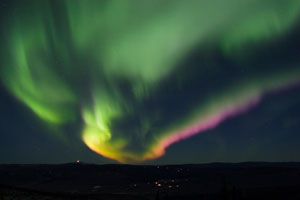Aurora Borealis
Aurora Borealis > About Us
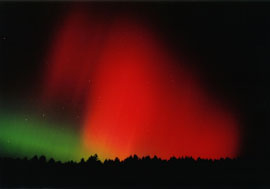 If you have ever seen an aurora light up the night sky with its shifting
waterfall of colors, you've seen one of the most amazing shows nature can
offer. What causes an aurora? When charged particles from the
magnetosphere collide with atoms in the earth's upper atmosphere, they
absorb extra energy that is expressed as light. As the sun causes
hydrogen and helium to fuse, protons and electrons are shot into
space. Known as the solar wind, this stream of particles blows past
the earth. As they blow past the earth, the earth's lines of
magnetism draw the particles toward the north and south magnetic poles,
where these lines converge. When the particles arrive in the
ionosphere, they collide with gas atoms and emit light. The color
of light they emit depends upon the type of gas the particles collide
with. Light that is dominated by emissions from atomic oxygen
causes a greenish and dark-red glow. Blue light is a result of
atomic nitrogen, while purple light is the result of molecular
nitrogen. Many other colors can also be seen.
If you have ever seen an aurora light up the night sky with its shifting
waterfall of colors, you've seen one of the most amazing shows nature can
offer. What causes an aurora? When charged particles from the
magnetosphere collide with atoms in the earth's upper atmosphere, they
absorb extra energy that is expressed as light. As the sun causes
hydrogen and helium to fuse, protons and electrons are shot into
space. Known as the solar wind, this stream of particles blows past
the earth. As they blow past the earth, the earth's lines of
magnetism draw the particles toward the north and south magnetic poles,
where these lines converge. When the particles arrive in the
ionosphere, they collide with gas atoms and emit light. The color
of light they emit depends upon the type of gas the particles collide
with. Light that is dominated by emissions from atomic oxygen
causes a greenish and dark-red glow. Blue light is a result of
atomic nitrogen, while purple light is the result of molecular
nitrogen. Many other colors can also be seen.
Recent Aurora Borealis News
- Northern Lights Forecast: These States May See Aurora Borealis Wednesday Night
Minor or greater geomagnetic storms were previously forecast.
By Ty Roush, Forbes Staff. Forbes. Wednesday, 17 Dec 2025 08:20:04 -0500. - Northern lights may be visible from these states Tuesday
Those who missed the stunning northern lights display in November may have another chance at witnessing the celestial phenomenon Tuesday night, depending on where they live.
Jeremy Tanner. The Hill. Wednesday, 10 Dec 2025 02:08:21 +0000.
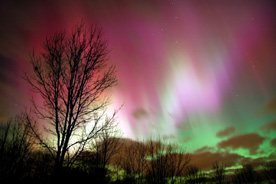 Auroras occur in both hemispheres, and the aurora in the northern
hemisphere is called the aurora borealis, or northern lights.
The aurora borealis gets its name from the mythical Roman goddess of the
dawn, Aurora, and the Greek name for north wind, Boreas. The aurora
borealis can often be seen on the northern horizon; it frequently appears
as a reddish glow, as if the sun were rising in the wrong direction.
The aurora borealis is most often seen during the months of September,
October, March, and April.
Auroras occur in both hemispheres, and the aurora in the northern
hemisphere is called the aurora borealis, or northern lights.
The aurora borealis gets its name from the mythical Roman goddess of the
dawn, Aurora, and the Greek name for north wind, Boreas. The aurora
borealis can often be seen on the northern horizon; it frequently appears
as a reddish glow, as if the sun were rising in the wrong direction.
The aurora borealis is most often seen during the months of September,
October, March, and April.
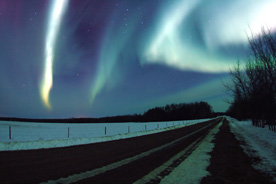 In many areas on northern latitudes, the aurora borealis was seen as a
symbol of approaching doom, and the phenomenon was regarded with fear and
superstition. As a result, the aurora borealis is prevalent in
folklore and myth, especially among the Inuit people who live in the
high, northern latitudes. One myth says that the aurora borealis
is past ancestors, while another myth says that the aurora borealis
is telling stories of what happened in the past and what will happen
in the future.
In many areas on northern latitudes, the aurora borealis was seen as a
symbol of approaching doom, and the phenomenon was regarded with fear and
superstition. As a result, the aurora borealis is prevalent in
folklore and myth, especially among the Inuit people who live in the
high, northern latitudes. One myth says that the aurora borealis
is past ancestors, while another myth says that the aurora borealis
is telling stories of what happened in the past and what will happen
in the future.
Fairbanks, Alaska, is known as one of the best places in the world to see the aurora borealis. It usually appears in the sky as light green, light yellow, and pink wisps, curtains, pillars, pinwheels, and haloes of light that seem to wave and vibrate.
Comprehensive information about the Aurora Borealis, as well as lists of Aurora Borealis resources, can be found on the University of Michigan's Aurora page and the University of Alaska Geophysical Institute's Aurora Forecast page. An impressive Northern Lights image gallery can be found at Virtual Finland.
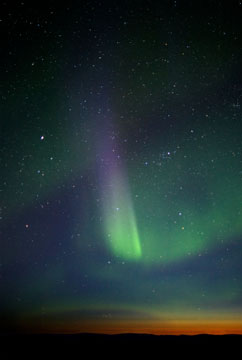 |
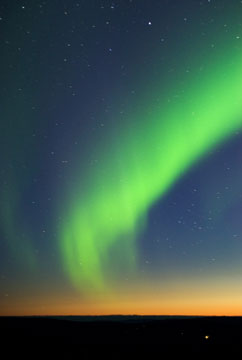 |
Aurora Borealis Description and Photographs
